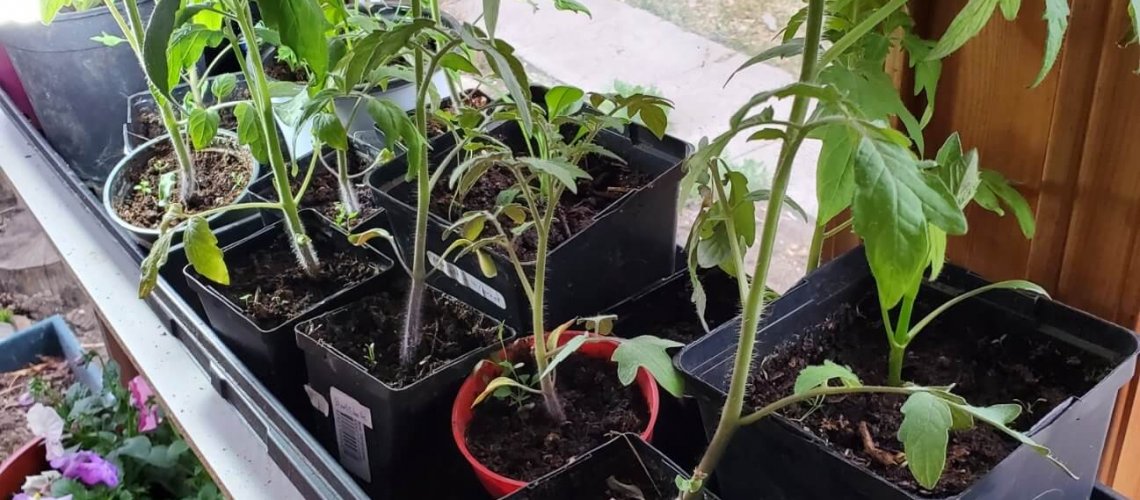Here in Alberta, the growing season is short. For some plants, you either have a choice of buying seedlings from a local garden market, or starting your own.
Seeds are a marvel of nature. Each tiny seed contains specialized cells that form roots, stems, leaves, and the nutrients for growth. To germinate they need heat, moisture, and oxygen from the soil. Most need light.
To get started on growing your own, buy potting soil, compost, pots or containers, and potting trays with clear plastic covers from your local garden market. It’s a good idea to make your own potting soil. I use a mixture of compost, potting soil, and a 2 cm topping of seed starting soil. Plants need oxygen to grow and before a plant has leaves, it must get the oxygen from the potting and seed starting soils. If you have a problem with weed seeds and pathogens in your compost, heat it in the oven to 150 degrees F to kill them.
Plant three or four seeds in each 2×2” pot at the depths recommended on the seed packages. Place them in a plastic potting tray, and cover them with a clear plastic top. Label the pots so you can recognize each seedling.
Water from the bottom; the plastic top keeps a high humidity for the seedlings. Do not overwater or the seeds may rot. Keep the top moist using a spritzer. After germination and after the first two leaves appear, transplant all but one into other 2×2-inch pots. Eventually, remove the clear plastic top. Seeds germinate best in a warm room at about 21 degrees C.
You will need grow lights. I find that the newer LED lights work best. They hang; adjust them to keep the manufacturer’s recommended distance above the top of the seedlings. You will know if the lights are too close; there will be light-burn, a bleaching or yellowing of the leaves. If that occurs, raise the lights. Provide 12 hours of light daily.
But when to start? If our weather pattern was stable in Alberta, I could say definitely. But it isn’t. And, so, I have found the following approximate best times for the various seedlings.
- End of March, start tomatoes and peppers in 2×2” pots
- End of March, plant your favorite herbs (such as basil, thyme, rosemary, parsley, or marjoram) in 6” pots. They will stay in the pot and you can bring them in in the fall.
- End of April – plant three cucumber seeds in a 15” x 15” container and remove the weakest after germination. Put the container outside in the first week of June. This will give you early cucumbers in July.
- End of April, plant three seeds each of squash and pumpkin in 6”-8” pots. Remove the weakest after germination.
I adjust for warmer or colder weather by keeping the seedlings longer in my sunroom or by covering the transplanted seedlings in case of frost. I plan to transplant from the middle to the end of May, when the threat of frost is over.
However, if you don’t want to start your own, buy from your favorite market garden and follow the rest of my recommendations.
To adapt to outdoor conditions, harden off the seedlings. Start with a couple of hours in an outdoor shaded area and gradually increase to up to a week in broad sunlight. Bring them in each night.
When transplanting seedlings, first check to ensure their roots have not circled the pot. If so, tease out the roots that have circled the pot and clip them off, taking care not to damage the larger roots. Then dig a hole, add some compost, a bit of bone meal, and water. Tamp the soil firmly around the seedling. Try to transplant on a cooler, cloudy day.
Prepare for watering tomatoes and squash by setting cans, with holes in the bottom, by each plant. To water, fill the can with water; this will water the roots and reduce surface evaporation.

One Response
I have really enjoyed reading your columns in the St. Albert gazette. I love to be outside and plant, and come from a very long line of relatives with a natural green thumb, however, it seems this natural skill was not passed down to me! Doing research is also difficult, since many books and even the labels on plants don’t take into account our unique prairie climate and short season. So, I look forward to trying to follow along with you this year! Thank you so much for taking the time to share your wisdom with us.